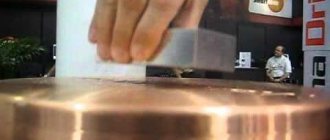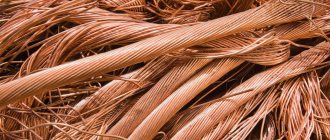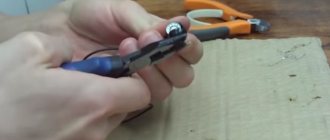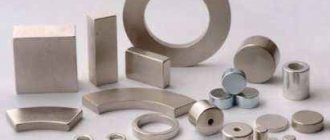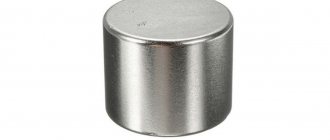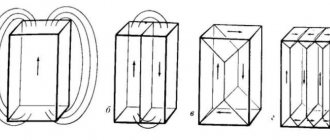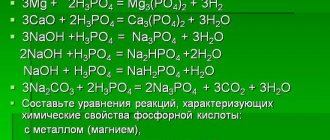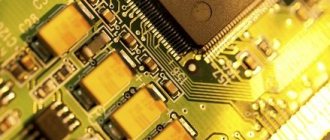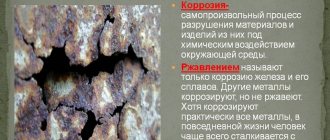Every magnet that we come across in life has a number of characteristic features. The main feature is the ability to be attracted to objects made of metal or steel. The second quality is the presence of poles.
Checking the poles is achieved by bringing one magnet closer to another. Opposite poles (south and north) attract. Identical poles repel each other.
A magnetic field
Electrons moving around an atom create a magnetic field while carrying a negative charge. When constantly moving, an electric current is produced. The magnetic field appears due to the movement of current, the strength of the current affects the strength of the magnetic field.
Given this information, we can conclude that there is a connection between magnetism and electricity. Collectively, this phenomenon is called electromagnetism.
The movement of electrons around the nucleus is not the only reason for the appearance of a magnetic field. It is no less influenced by the movement of atoms around their axis. Individual materials have a magnetic field in which atoms suppress each other, carrying out chaotic movement.
Metal objects have ordered groups of atoms oriented in a certain direction. Thanks to the ability to direct atoms in a given direction and add magnetic fields, metal objects are able to be magnetized.
Magnetic and electric current
The magnetic field is generated by electric current, that is, by moving electrons. Electrons moving around an atomic nucleus carry a negative charge. The directed movement of charges from one place to another is called electric current. An electric current creates a magnetic field around itself.
Magnetic field lines
This field, with its lines of force, like a loop, covers the path of electric current, like an arch that stands over the road. For example, when a table lamp is turned on and a current flows through the copper wires, that is, the electrons in the wire jump from atom to atom and a weak magnetic field is created around the wire. In high-voltage transmission lines, the current is much stronger than in a table lamp, so a very strong magnetic field is formed around the wires of such lines. Thus, electricity and magnetism are two sides of the same coin - electromagnetism.
How do magnets attract and repel?
How are magnets attracted? A force arises between magnets brought close to each other. The attraction or repulsion of magnets is felt not only during direct contact. There is interaction even without contact.
Magnets will repel each other if their north poles are brought close to each other. When the south poles contact, a similar picture will be observed. However, attraction will arise between the magnets if the south pole is brought close to the north pole. This principle works similarly to electric charges. In this case, the poles of magnets and electric charges are different phenomena.
Traditional materials for permanent magnets
They have been actively used in industry since 1940 with the advent of alnico alloy (AlNiCo). Previously, permanent magnets made of various types of steel were used only in compasses and magnetos. Alnico made it possible to replace electromagnets with them and use them in devices such as motors, generators and loudspeakers.
This penetration into our daily lives received a new impetus with the creation of ferrite magnets, and since then permanent magnets have become commonplace.
The revolution in magnetic materials began around 1970, with the creation of the samarium-cobalt family of hard magnetic materials with previously unheard-of magnetic energy densities. Then a new generation of rare earth magnets was discovered, based on neodymium, iron and boron, with a much higher magnetic energy density than samarium cobalt (SmCo) and at an expectedly low cost. These two families of rare earth magnets have such high energy densities that they can not only replace electromagnets, but be used in areas that are inaccessible to them. Examples include the tiny permanent magnet stepper motor in wristwatches and the sound transducers in Walkman-type headphones.
The gradual improvement in the magnetic properties of materials is shown in the diagram below.
For what reason are not all materials capable of magnetization?
A magnet interacts with a wide range of substances. The type of interaction is not limited to attraction or repulsion. Certain metals and alloys have a specific structure, which makes it possible to be attracted to a magnet with a certain power.
Other materials also have this property, but on a smaller scale. To detect attraction under such conditions, it is necessary to create a very strong magnetic field. This is not possible at home. Why do all materials have the property of attraction, but only metal can be perceived as magnetic? The answer lies in the special external structure of atoms.
The things around us are made up of atoms connected to each other. The type of connection between them determines the material. The atoms in most substances are poorly grouped, so the bond with the magnet is weak. In a metal, atoms are well coordinated; all atoms synchronously sense the magnetic field and are drawn towards it.
Natural science research
Oersted, conducting experiments with a magnetic needle and a conductor, noticed the following feature: a discharge of energy directed towards the needle instantly acted on it, and it began to deviate.
The arrow always deviated, no matter from which side he approached.
A physicist from France, Dominique François Arago, began repeated experiments with a magnet, using as a basis a glass tube rewound with a metal thread, and he installed an iron rod in the middle of this object. With the help of electricity, the iron inside began to be sharply magnetized, because of this various keys began to stick, but as soon as the discharge was turned off, the keys immediately fell to the floor. Based on what was happening, a physicist from France, Andre Ampere, developed an accurate description of everything that happened in this experiment.
How magnets are made in different ways
Features of street lamps with light sensors: installation and configuration tips
Pressed magnets are magnets made by mixing a special type of NdFeB powder with polymer binding materials. This mass is then pressed into a mold and heated.
Magnetic products obtained in this way can be of complex shapes and usually do not require additional processing. They have lower product energy than sintered magnets, up to 10 MGse.
By using special solenoids, it is possible to obtain multi-pole magnets or magnets with a special shape of the magnetic field.
Of course, such complex solenoids can be very expensive depending on the complexity of the design and the required performance.
Cast magnets - in this method of producing magnets, NdFeB powder is mixed with a polymer material and extruded into a mold. The resulting magnetic products have product energies of up to 5 MGse, but can be made into intricate shapes.
Sintered neomagnets - fine NdFeB powder is pressed into a mold, then sintered and processed to the desired size (ground).
The production of neodymium magnets is a complex high-tech process that requires compliance with the composition and impurity content. All operations, except for grinding to size, are carried out without oxygen in a vacuum or an atmosphere of inert gases. The direction of magnetization is determined by the texture of the magnetic field during pressing.
Permanent magnet motor
In recent decades, DC motors have become widespread. Such a unit consists of the electric motor itself and an electronic commutator for its armature winding, which performs the functions of a collector. The electric motor is a synchronous motor with permanent magnets located on the rotor, as in Fig. above, with a stationary armature winding on the stator. Electronic switch circuitry is an inverter of direct voltage (or current) of the supply network.
The main advantage of such a motor is its non-contact nature. Its specific element is a photo-, induction or Hall rotor position sensor that controls the operation of the inverter.
Magnetization curve
Starting from the unmagnetized state, when H increases from zero, due to the orientation of all atomic moments in the direction of the external field, M and B quickly increase, changing along section “a” of the main magnetization curve (see figure below).
When all atomic moments are equalized, M comes to its saturation value, and a further increase in B occurs solely due to the applied field (section b of the main curve in the figure below). When the external field decreases to zero, the induction B decreases not along the original path, but along section “c” due to the coupling of atomic moments, tending to maintain them in the same direction. The magnetization curve begins to describe the so-called hysteresis loop. When H (external field) approaches zero, the induction approaches a residual value determined only by atomic moments:
Br = μ0 (0 + Mg).
After the direction of H changes, H and M act in opposite directions and B decreases (part of the curve “d” in the figure). The value of the field at which B decreases to zero is called the coercive force of the BHC magnet. When the magnitude of the applied field is large enough to break the cohesion of the atomic moments, they are oriented in the new direction of the field, and the direction of M is reversed. The field value at which this occurs is called the internal coercive force of the permanent magnet MHC. So, there are two different but related coercive forces associated with a permanent magnet.
The figure below shows the basic demagnetization curves of various materials for permanent magnets.
It shows that NdFeB magnets have the highest residual induction Br and coercive force (both total and internal, i.e., determined without taking into account the strength H, only by the magnetization M).
Supermarkets
Classic supermarkets with an area of up to 2100 sq.m. with a wider assortment than that of convenience stores, located within walking distance in residential and business areas, as well as in shopping centers. The format involves more attention to customer comfort and a pleasant shopping atmosphere, while maintaining attractive prices for the entire range.
Compact city hypermarkets, sales area 2100-3000 sq.m. A modern and technologically advanced large format for the whole family, located within the city within walking distance. A store with an expanded assortment in all categories of goods, including under Magnit’s own brands, with an emphasis on fresh and ultra-fresh, useful services, dedicated children’s and healthy lifestyle areas, its own cafe and its own cooking.
Start 3D tour
Cash&Carry format, aimed at private buyers and small businesses interested in large purchases at low prices. from 2022. The store has wide aisles for cargo carts, the ability to load goods from a ramp, as well as a wholesale manager who will help you order goods and document the purchase. The format has a progressive discount system, providing significant savings for larger purchase volumes.
What can you catch?
Fragments of historical monuments - knives, weapons from the times of the Great Patriotic War - are often recovered from the bottom of lakes and rivers. A magnet with good attractive force will pull out hidden treasures in wells and garbage pits. Cossack sabers were repeatedly raised from the Dnieper. All products containing iron and ferromagnetic metals will be attracted to the magnet.
Pure gold is not magnetized, but such jewelry also contains a ligature (a mixture to impart strength). For example, products of 585 standard contain 41.5% other metals, including nickel, which is highly attractive.
You can also find silver, but not all its varieties can be raised. Sets of past centuries, with the addition of ligature, are often mined from the depths of centuries-old lakes.
Stainless steel is magnetic to varying degrees, depending on the alloys added. Aluminum, brass, bronze, tin, lead and copper will not be attracted.
Often in your finds you can find metal sealed cylinders worn by German soldiers. They kept their valuables in them.
Places to find relics
Ideal search places are military crossings and centuries-old bridges. Valuable finds can be discovered when examining mill whirlpools and pre-revolutionary wells. The drains, cesspools and station toilets surprise you with their artifacts.
Search for valuable coins
Only cheap royal change will not be attracted to the magnet, but medium-denomination coins made with an admixture of nickel and chromium will delight their treasure hunter. You shouldn't count on expensive coins, because... They were made of gold and silver, which means they are very weakly magnetized.
Neodymium permanent magnets
They represent the latest and most significant development in this field over the past decades. Their discovery was first announced almost simultaneously at the end of 1983 by metal specialists from Sumitomo and General Motors. They are based on the intermetallic compound NdFeB: an alloy of neodymium, iron and boron. Of these, neodymium is a rare earth element extracted from the mineral monazite.
The enormous interest that these permanent magnets have generated arises because for the first time a new magnetic material has been produced that is not only stronger than the previous generation, but is more economical. It consists mainly of iron, which is much cheaper than cobalt, and neodymium, which is one of the most common rare earth materials and has more reserves on Earth than lead. The major rare earth minerals monazite and bastanesite contain five to ten times more neodymium than samarium.

